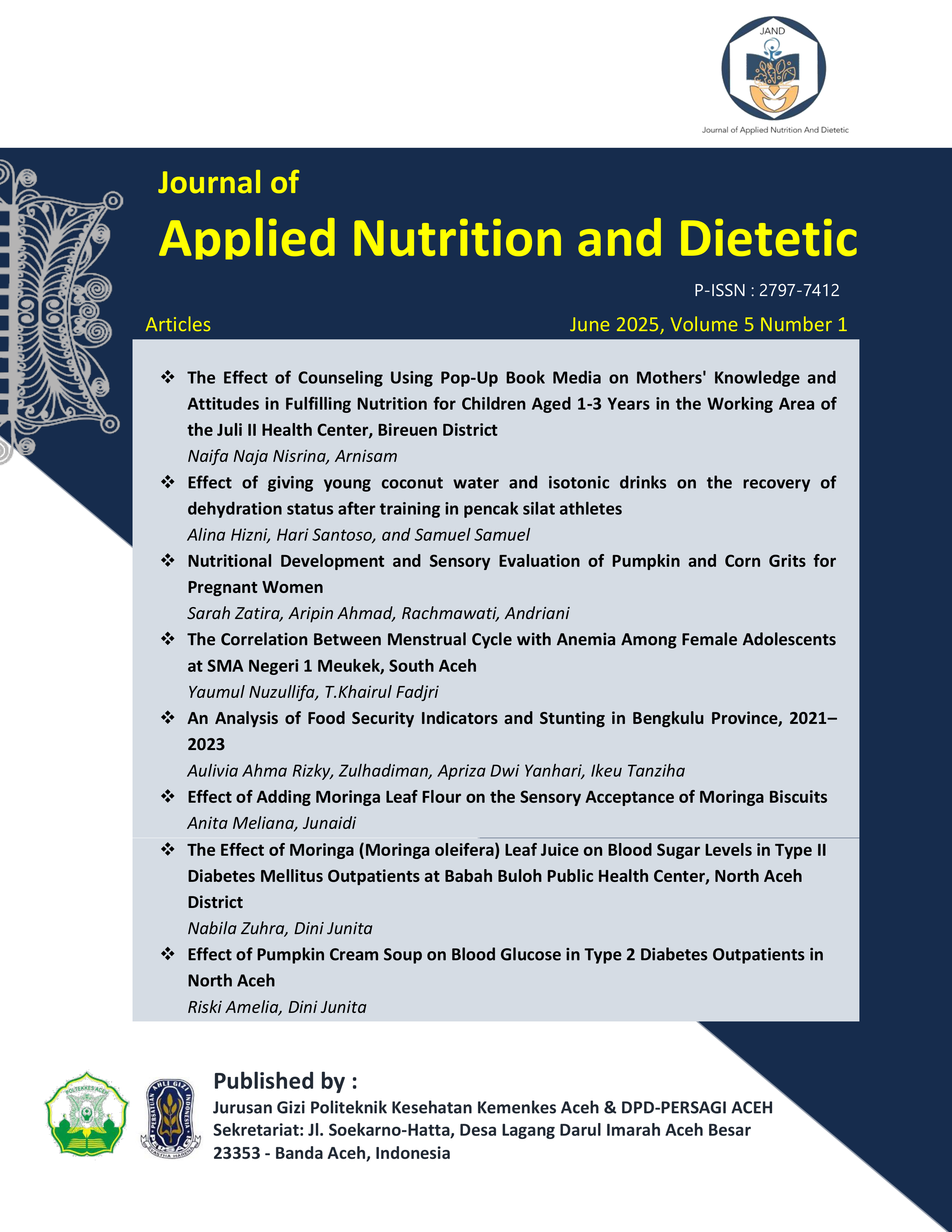Effect of Adding Moringa Leaf Flour on the Sensory Acceptance of Moringa Biscuits
DOI:
https://doi.org/10.30867/jand.v5i1.363Kata Kunci:
acceptability, biscuits, moringa leaf, supplementary food, toddler nutritionAbstrak
The Recovery Food Supplement (PMT) program is a government initiative aimed at improving the nutritional status of toddlers by providing food supplements in addition to their daily intake, particularly for undernourished children. One form of PMT is the toddler biscuit, formulated to contain a minimum of 160 kcal, 3.2–4.8 g of protein, and 4–7.2 g of fat per 40 g serving. According to technical guidelines, PMT targets children aged 6–59 months who are categorized as underweight (weight-for-height < –2 SD) and is administered for 90 days. To determine the effect of adding Moringa leaf flour on the acceptability of Moringa-based biscuit snacks. This study employed a non-factorial Completely Randomized Design (CRD) with three treatments: Y1 (40 g cornstarch + 10 g Moringa leaf flour), Y2 (40 g cornstarch + 15 g Moringa leaf flour), and Y3 (40 g cornstarch + 25 g Moringa leaf flour). Organoleptic tests assessed color, taste, aroma, and texture parameters. Data were analyzed using ANOVA. ANOVA results showed no significant effect on color (p = 0.216), aroma (p = 0.753), or texture (p = 0.877). However, a significant difference was found in the taste parameter (p = 0.034), indicating that the addition of Moringa leaf flour influenced the flavor of the biscuits. The addition of Moringa leaf flour significantly affected the taste of Moringa biscuit snacks but had no significant effect on color, aroma, or texture. Future research should consider using a standardized baking temperature across all treatments and explore higher concentrations of Moringa leaf flour to enhance the nutritional content of the product.
Referensi
Aprilianti, T. (2010). Study of the physicochemical and sensory properties of purple sweet potato flour (Ipomoea batatas blackie) with variations in the drying process [Undergraduate thesis, Sebelas Maret University]. Faculty of Agriculture, Sebelas Maret University.
Daughter, W. (2018). Evaluation of the Recovery Supplementary Feeding Program on the nutritional status of toddlers in the working area of the Bukit Surungan Community Health Center, Padang Panjang City in 2017 [Undergraduate thesis, Andalas University].
Gayatri, M. (2019). The effect of adding dates (Phoenix dactylifera) to the agar-agar combination of Aloe vera (Aloe vera var. chinensis) on organoleptic quality and antioxidant activity [Undergraduate thesis, STIKES Perintis Padang]. Nutrition Study Program.
Indonesian Ministry of Health. (2017a). Nutritional status monitoring results (PSG) and explanations for 2016. Jakarta: Ministry of Health, Republic of Indonesia.
Indonesian Ministry of Health. (2017b). Technical instructions for providing supplementary food for toddlers, school children, and pregnant women. Jakarta: Ministry of Health, Republic of Indonesia.
Indriasari, Y., Basrin, F., & Salam, M. (2019). Analysis of consumer acceptance of Moringa biscuit (Moringa biscuits) enriched with Moringa leaf flour (Moringa oleifera). Agroland: Jurnal Ilmu-Ilmu Pertanian, 26(3), 221–229. https://core.ac.uk/download/pdf/296928689.pdf
Irwan, Z., Salim, A., & Adam, A. (2020). Provision of cookies from Moringa leaf and seed flour to the weight and nutritional status of children under five in the Tampa Padang Health Center area. Action: Aceh Nutrition Journal, 5(1), 45–54. https://doi.org/10.30867/action.v5i1.198
Krisnadi, A. D. (2015). Super nutrition moringa. Blora: Center for Information and Development of Indonesian Moringa Plants.
Nofaliana. (2013). The effect of adding wheat flour on the acceptability, carbohydrate content, and fiber content of banana weevil prole cake [Undergraduate thesis, Jember University]. Faculty of Public Health.
Rahayu, T. B., Anna, Y., & Nurindahsari, W. (2018). Improving the nutritional status of toddlers through giving Moringa leaves (Moringa oleifera). Jurnal Kesehatan Madani Medika, 9(2), 87–91. https://doi.org/10.36569/jmm.v9i2.14
Winarno, F. G. (2004). Food chemistry and nutrition. Jakarta: PT Gramedia Pustaka Utama.
Unduhan
Diterbitkan
Cara Mengutip
Terbitan
Bagian
Lisensi
Hak Cipta (c) 2025 JAND: Journal of Applied Nutrition and Dietetic

Artikel ini berlisensiCreative Commons Attribution-ShareAlike 4.0 International License.











